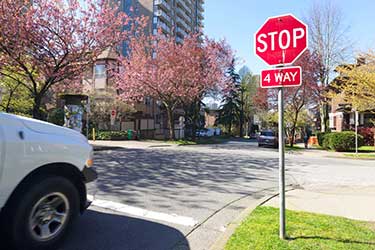
Written by Kayla Jane Barrie Updated on Mar 03, 2025 5 mins read

One of the most misunderstood rules of the road is right-of-way. Right-of-way is determined by traffic signs, signals, and province-set rules. Knowing who has the right-of-way helps with traffic flow and reduces car accidents.
You are expected to drive defensively and yield the right-of-way to oncoming vehicles, pedestrians, and cyclists. If an accident occurs, police will consider right-of-way when writing a ticket. Insurers could also use right-of-way when assessing fault for an accident claim, which can impact your Ontario car insurance in the future. Here we discuss the most common situations where you should give right-of-way to others on the road.
Right-of-way refers to situations on the road when you must let another driver go first. You must yield to other vehicles in many situations at intersections, highways, and roundabouts.
Simply signalling does not give you the right-of-way in any of these situations. As a driver, you are responsible for ensuring the way is clear before moving forward. This will help keep you and other drivers safe. In return you'll have more affordable car insurance quotes in the future.
The driver with right-of-way depends on the type of stop, intersection and situation :
Always yield to oncoming traffic crossing in front of you at a two-way stop. If you are making a left-hand turn at the stop, you are expected to yield to vehicles facing you (even if you got there first). Imagine if you were at an intersection with lights – no matter who arrived first, when the light turns green, you must wait for oncoming traffic to pass before proceeding. If you both stop simultaneously and the way is clear, the vehicle to the right goes first.
Through traffic has the right-of-way at a three-way stop. If you and another vehicle stop at the same time, the vehicle on the right will have the right-of-way. The same rule applies at T-intersections.
The first vehicle to enter has the right-of-way at a four-way stop. If two or more cars stop at the same time, right-of-way goes to the vehicle on the right. Be patient – if someone goes forward without obeying right-of-way, wait your turn.
Drivers must yield to pedestrians crossing the street while the walk signal or countdown is on or when pedestrians use a crossover. A crossover is a designated spot in Ontario where pedestrians can cross, although there are no traffic lights.
In these situations, drivers must stop their vehicles for pedestrians and not proceed until the pedestrian is on the sidewalk. Drivers can't pass a car that is stopped at a pedestrian crossover or when a moving vehicle is within 30 metres from a crossover.
Whenever a crossing guard is present, drivers must wait until all pedestrians, including the crossing guard, have entered the sidewalk.
Any car merging onto a highway or ending lane must yield the right-of-way to vehicles already on the road. If you are travelling on the road, you have the right-of-way over anyone merging. When you are merging, take notice of oncoming traffic through your mirrors and enter when there is a safe gap.
Highway right-of-way refers to when you should yield to cars on the highway. Freeway traffic that is already moving has the right-of-way. When it is safe, you can merge or pass when necessary. You must yield to all oncoming traffic when merging onto a highway ramp. The merging lane does not have the right-of-way.
Drivers in the traffic lane have the right of way over vehicles exiting parking spots. When you are exiting a parking spot, you must yield to all oncoming traffic. If you are exiting a spot and get into a parking lot accident, you would be at fault.
Drivers must take notice of and obey all signs in a parking lot. There will be signs to direct pedestrians right-of-way and the proper lane they should enter and exit. When driving through parking lots, always drive slowly and keep an eye out for cars exiting spots.
Drivers, cyclists and pedestrians who are using the roundabout have right the right-of-way. Vehicles entering must yield and wait for a safe gap to enter. Look for pedestrians who might be crossing and give them space and time to cross safely.
Generally, you should yield right-of-way too :
Drivers who are already driving on the highway have the right-of-way on a highway. When merging from a highway ramp, freeway drivers should move over if it is safe so the merging car has space. It is the driver’s responsibility to enter when there is space and drive according to the speed.
Oncoming traffic has the right of way while making a left-hand turn. Always check for pedestrians who might be crossing. When making a left turn, it is the driver's responsibility to make sure the way is clear before turning.
One of the few times a driver making a left turn has the right-of-way is when they have an advance green light. Whether it's a flashing light or an arrow, drivers will have the right-of-way to proceed.
When making a right-hand turn, pedestrians and vehicles have the right-of-way. Once they cross, and there is no oncoming traffic, you are good to make a right turn. Unless there is a sign or you are driving in Montreal, it is legal to make a right-hand turn at a red light.
If you are pulling out of a driveway (residential or commercial), you must always yield right-of-way to the drivers on the street or in the parking lot.
When in doubt, yield to any vehicle that is already moving in a forward direction if you are planning to move from a stopped position. As a driver, it is your responsibility to know the driving laws and when to take the appropriate steps to keep yourself and others safe.
Oncoming traffic as the right-of-way at a green light. If you make a left-hand turn, you must wait for the space to be clear of cars and pedestrians.
If cyclists are in a bike lane, they have the right-of-way. As a driver, you must yield to all bikes coming through when you are making a left or right turn.
When entering a construction zone, check for signs and a flag person who will direct what direction you need to yield to or completely stop.
Horse-drawn wagons or persons riding a horse have the same obligations and rights as pedestrians. If they are in front of you and making a left or right, give them the space to do so safely. Slow down and give them space when passing.
If there is a power loss at an intersection, always yield to vehicles which are entering the intersection from your right. Use the intersection as you regularly would at a four-way stop to keep traffic moving.
| Categories | Auto |
|---|---|
| Tags | Driving Tips |
Read our insurance blog to get helpful tips, information and news.
Think refusing a breath test helps your case? In Ontario, it results in a minimum fine of $2,000 and a criminal record. Compare the penalties and protect your future.
Impaired driving in Ontario is a serious offence. Learn about impaired driving fines, penalties, statistics and other important information all drivers in Ontario need to be aware of before they get behind the wheel.
Learn why parking violations are non-moving, how long they stay on your record, and the serious indirect risk of unpaid tickets.
Has your car been totalled in an accident? Is your car a write off? Learn about vehicle write offs for a total loss insurance claim.